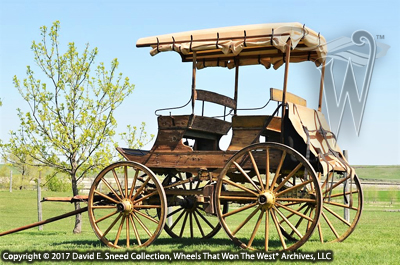It’snot unusual for us to receive hundreds of questions each year related tohorse-drawn vehicles. Many of thoseinquiries focus on details connected to the restoration of a particular set ofwheels. Paint colors, striping, designcontours, logos, dealer info, and other considerations are among theparticulars that can change between vehicles and years. As a result, for any authentic work to bedone, it’s important to know as much as possible about the vehicle while understandingthe ramifications of any work engaged.
Aswith the restoration of an antique piece of furniture, or even anextraordinarily significant car or truck, the process of correctly refurbishinga wagon or western vehicle should be approached with great care. After all, with any valued work of functionalart, architecture, or history, there is an irreplaceable heritage contained withinthe parts of the whole. Stress cracks,age stains, wear marks, and decades of patina all tell a story. Covering up or removing those connections toyesterday – even with a well-meant restoration – might negatively affect resale values and historic visual appeal. Ultimately, it’s important to first determine if preservation orconservation efforts might be a better approach.
Preservation of a piece describes efforts to keep it the same with minimal (if any) changes to the structure. Exceptionally rare andhistorically significant pieces are often the ideal candidates for the limited impact of preservation work.
Similarly,Conservation of a set of wheels meansthat the vehicle should remain as unaltered as possible. Any repairs or replacement parts should matchthe original and be removable or reversible in the future if needed. The maximum amount of original wood, paint,and metal should be retained.
Bydefinition, Restoration involves the bringingback of a piece to a former condition. Whilethis direction often involves the most change to the vehicle, it should also beentered into with care. Aptly approached,restoration of a wood-wheeled vehicle requires comprehensive knowledge of thevehicle parts and whole; ultimately ensuring that all elements are faithfullyrepresentative of the vehicle as originally constructed.
Amongthe points that are important to all aspects of preservation, conservation, andrestoration projects are...
1. Authenticatingthe brand & maker – There are numerous variables that can make thistask a real challenge. While someidentities are fairly easy to point out, others are much more complicated. Why? Well, over the years, some vehicle parts have been assimilated with those of otherbrands, making it crucial to view multiple areas for correct assessments. In other instances, the primary maker may beknown but the actual brand could be more obscure. Builders like International Harvester, forexample, had many separate brands with similar to exact features. In these types of circumstances, it takescareful, detailed study over multiple decades of manufacture to hone in on thecorrect brand. Additionally, even if anoriginal brand name is still visible on the vehicle, it’s important to realizethat there often were numerous brands with the same name. Smith, Whitewater, Keller, Miller, Pioneer,Rushford, and many others are just a few names that had multiple makers.
2. Confirming the time frameof manufacture- Thisis crucial to analysis of a wagon that's missing all or most of its paint. Different time frames were often met withdifferent paint colors, striping, seat designs, decalcomines, hardware, wheeldesigns, gear configurations, wood types & sizes, and other features. Placing the wrong paint scheme on a vehicle is a poor reflection on the finished piece.
3. Identifying thetype of vehicle– This may seem like an obvious statement but, oftentimes, there is a noticeabledifference between the way a farm wagon was painted compared to a very similarvehicle like a mountain wagon, potato wagon, rack bed wagon, or another relateddesign. As a result, it's important to ensure that all work corresponds to the vehicle type.
4. Documentation ofthe areas of originality – Over the decades, I’ve seen a lot ofmismatched elements on wagons and western vehicles. It might be something as small as a box rodor something larger like wheels substituted from another brand or maybe even thewrong doubletree/singletree design. Inthe old days, it was easier to assume an old set of wheels was exactly what itappeared to be – an original relic with an untainted connection to days goneby. Nowadays, all bets are off. Making things even more complicated, it’sfairly common to see Canadian vehicles mixed in with American wagons as well asalmost any imaginable combination of brands thrown together to make onewagon. Knowing who did what, when, how,and where can be invaluable to assuring you have what you think you do.
5. Recording thelevel of completeness – This can include the notation of missing ordamaged pieces. It’s one more area thatcan be difficult to determine, especially if primary source confirmations arescarce.
6. Chronicling thedealership / region where sold – This information can be especially helpfulwhen determining provenance, time frames of manufacture, and authenticitylevels.
7. Determining wheel,skein, & track sizes – Again, these elements help share animportant voice of the vehicle. Eachoffers another set of clues to help confirm authenticity, originality, andproper design features.
Dueto the continuing escalation of certain vehicle values, we encourage carefulconsideration prior to changing any aspect of a wooden wagon’s condition. Original surfaces cannot be duplicated oncethey are changed. Valuable provenanceand historical integrity as well as the vehicle’s impact on future generationsare always important thoughts to reflect upon before deciding which approach isbetter... Preservation, Conservation, or Restoration?
Thanks for stopping by today. By the way, if you haven’t signed up to receive this weekly blog via e-mail, just type your address in the "Follow By E-mail" section above. You'll receive a confirmation e-mail that you'll need to verify before you're officially on board. Once that's done, you'll receive an email every time we update the blog. Please don't hesitate to let us know if we can be of assistance. We appreciate your continued feedback and look forward to sharing even more wooden vehicle info in the coming weeks.
Please Note: As with each of our blog writings, all imagery and text is copyrighted with All Rights Reserved. The material may not be broadcast, published, rewritten, or redistributed without prior written permission from David E. Sneed, Wheels That Won The West® Archives, LLC

